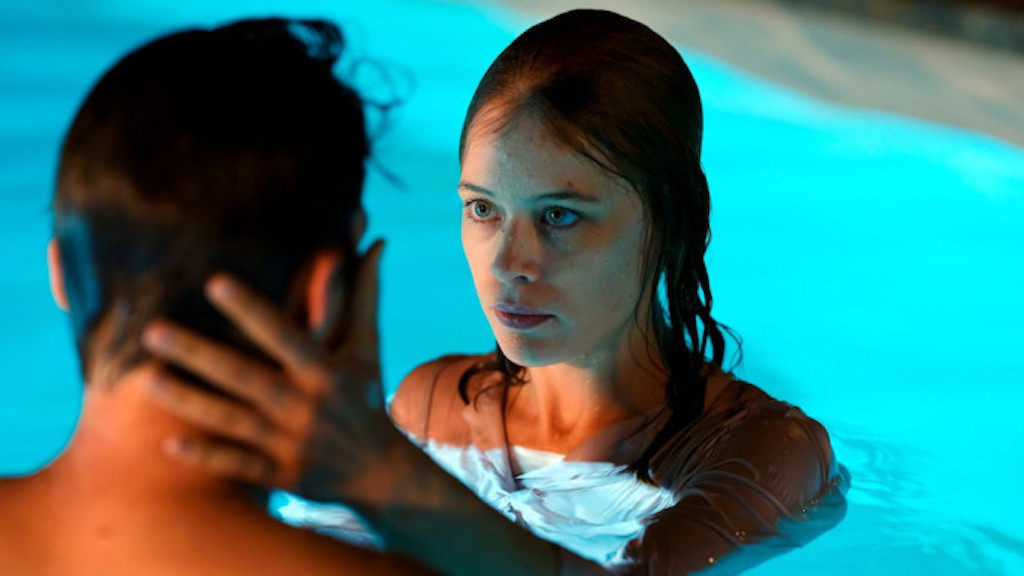
There are few people unfamiliar with the Dutch fable of “The Little Mermaid”: a woman from the sea pursues her love for a land-dwelling man to attain a human soul. It is the basis for an assortment of romance productions across film, theater, and other mediums (Disney’s The Little Mermaid franchise, for example). However, most people are probably unfamiliar with the fable’s origin: the European myth of the undine, a water sprite who similarly seeks the love of a man to obtain a human form, and is doomed to die if he falls out of love. The fabled tale is the inspiration for Christian Petzold’s romance drama Undine, which completed its US theatrical run this past summer.
Petzold’s film follows Undine, the titular water sprite who inhabits the form of a Berlin historian and is reeling from the end of a romantic relationship with her former lover, Johannes. The film begins with them at a cafe as Undine processes Johannes’s admission of guilt, of his cheating and desire to separate. Undine returns to her job, telling Johannes to wait at the cafe until her break so they can continue their conversation. However, she later returns to the cafe only to find that Johannes has left. As she searches around for him, Undine encounters a vibrating fish tank, in which a miniature diver figurine speaks to her, and Christoph, an industrial diver and an attendee from one of her tours, who asks Undine out. Undine grabs Christoph as the tank breaks and they both fall to the ground, fulfilling the film’s part-charming, part-fantastical meet-cute. As the newly found lovers become increasingly intimate, Undine faces conflicts stemming from her previous relationship and her supernatural existence.
This surreal setup is met with Petzold’s stringent and realistic direction, which opts to create a fairy tale grounded in reality. Petzold has risen as one of Germany’s most prominent filmmakers over the past decade, emerging out of the Berlin School movement that formed during the early twenty-first century, a niche group of filmmakers focused on deep analyses of interpersonal relationships, German politics, and social realism. His string of acclaimed feature films over the past decade, which include Barabara, Phoenix, and Transit, exhibit his Berlin School realism and politicization, as well as an increased fascination with the relationship between life and death. Undine boasts Petzold’s signature style, as well as an expansion into surrealism and aspects of European folklore. From the onset, the film’s minimalist style is exacted through its production design from Merlin Ortner, its efficient simplicity achieving smooth narrative progression as well as a muted, everyday beauty. The cinematography by Hans Fromm is similarly minimalist, only verging from standard realist fare occasionally. There are only two tracks that fill the score, an adagio of Bach’s Concerto in D Minor and the Bee Gees’ “Stayin’ Alive”, each personifying the juxtaposing tones of the film. But that is not to say that the film is quiet — rather, it is evidence of Undine’s economic pacing and tight script.
The culmination of Petzold’s minimalist style and Undine’s surrealism results in some visually striking and memorable sequences. The enigmatic and ominous tones surrounding the narrative are elegantly captured in the underwater sequences, particularly the final scene in which we see Undine’s mythical form. Her body unsettlingly and slowly floats towards Christoph in a fashion between sentience and unconsciousness, as if between life and death, her fate forever sealed to live an aquatic nonexistence. The more realistic out-of-water sequences also give Undine heart and levity, largely because of the playfulness and intimacy between the two leads, Paula Beer (Undine) and Franz Rogowski (Christoph). As when Christoph runs alongside Undine’s arriving train, the central romance proves to be just as enveloping as Undine’s omen.
Beer and Rogowski, who previously co-starred in Petzold’s 2018 film Transit, are well cast in Undine, each giving their characters nuance and emotional depth. Beer brings a distinct subtlety to Undine, as evident by her drifting, calculating stares amid several dialogue scenes. Undine is also given warmth and sweetness by Beer’s performance, most notably when Christoph meets her at a train station and Undine affectionately embraces him. One of the more indelible scenes of Petzold’s film, and proof of Beer’s craft, occurs when Johannes returns and converses with Undine at the cafe from the opening scene. As Johannes apologizes and seeks to restore his relationship with her, Undine’s cautious glare is met with an unwitting half-smile, as if she is uncertain of what she will do or what will happen to them. While the rest of the cast isn’t given the same amount of opportunities and material as Beer, Rogowski still manages to maintain a complexity to his character, imbuing Christoph with a charisma and sincerity antithetical to Johannes’ manipulative infidelity.
But despite Petzold’s proficiency over the compact narrative and character interactions, Undine’s biggest shortcoming is its inaccessibility to audiences that are unfamiliar with the source myth. As mentioned before, there are two rules from the undine myth that influence Petzold’s film: Undine becomes human when she is loved and dies when she is not. These two rules are never clearly established or explicitly explained, as the narrative begins in media res when Johannes breaks up with Undine. When the film enters its second half and opens more towards its mythological aspects, most of the intrigue of Undine is lost, as those who don’t know the myth try to interpret what is happening and may be ignorant of the film’s subversion from its source material (allowing an undine to determine her fate).
While his film may prove to be needlessly confusing for some audiences, Petzold’s command of the film medium and his realistic, intimate style are palpable and noteworthy. As the star-crossed lovers become increasingly entangled in a thread of love and heartbreak, viewers of Undine are left with a superbly intimate and enjoyable reinvention of a quintessential European myth.